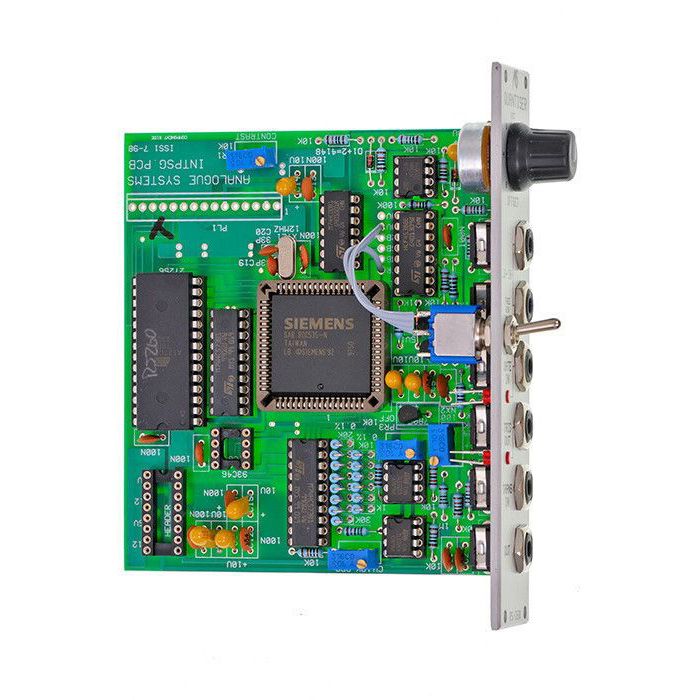 Купить Analogue Systems RS-260 Quantiser - лучшая цена с доставкой по России в mustore.ru
Купить Analogue Systems RS-260 Quantiser - лучшая цена с доставкой по России в mustore.ru Analogue Systems RS-260 Quantiser
Voltage Quantiser
This quantiser module corrects voltages according to the chromatic semitone scale i.e. one volt is divided into 12 voltage steps of same size (1/12V).
Sometimes it would be nice to spend more time playing your sequences than adjusting every knob minutely to keep them in tune. On other occasions, you might want the output from your Sample & Hold to be in semitones (i.e. 'real' notes) rather than totally random pitches. Then there are the occasions when it would be nice to be able to generate glissandos instead of smooth portamento (or 'glide') effects. Fortunately, there is a single device that makes all of these possible. It's a Voltage Quantiser.
A Voltage Quantiser is simply a device that rounds every voltage passing through it up or down to an exact semitone. It does this by making sure that all the output voltages conform to the logarithmic relationship that defines the well-tempered scale for a 1V/oct synthesiser.
So, if the set-up of the knobs on your sequencer is not quite perfect, the quantiser will correct them for you. Similarly, any voltages output by the S&H will be rounded to a semitone, so that every note is random but lies on one of the 12 semitones of the conventional scale. Finally, as far as these three examples go, a smoothly varying voltage such as a slow triangle wave from an LFO or a 'slewed' voltage smoothed by one of the Integrators SLEW modules will be cut up and output in semitone steps.
The RS-260 incorporates software that ensures glitch-free transitions between quantised notes. It also offers two operational modes. Free Run shifts the CV every time it changes enough to move from one semitone to another, whereas Gate requires a pulse to tell the device when to determine the next note. Gate is particularly useful because it means that you can clock the output for advanced rhythmic and polyrhythmic effects.
Особенности устройства с сайта производителяCV Inputs: V-IN 1 and V-IN 2
Any two voltages in the range 0v to +5v presented to the V-IN 1 and V-IN 2 inputs are summed linearly by an internal mixer. The summed voltage will also lie within the range 0v to +5v, giving a maximum quantised range of 5 octaves.
TRANS (Transpose) IN
A voltage applied at TRANS IN will be added to the summed voltages from V-IN 1 and V-IN 2. This will transpose the output up or down allowing you, for example, to transpose all the notes in a sequence passing through the Quantiser.
OFFSET
You can apply a fixed transposition (offset) of up to 2 octaves to the output. This is applied at the output so it is not quantised, and is normally used for fine-tuning purposes.
Mode Select Switch
There are two operational modes, selected using the FREE RUN/GATE switch.
- FREE RUN
In Free Run, the RS-260 outputs a new CV every time the mixed input CV changes enough to move from one semitone to another. - GATE
In Gated mode, the RS-260 requires a pulse to tell the device when to determine the next note.
GATE IN
If the Quantiser is in GATE mode, you must apply a Gate pulse in the range +1v to +20v to this input to cause it to determine the output voltage. The output is determined on the positive-going edge of the pulse, and will be held until the next positive-going pulse is received. The GATE IN LED will light when a suitable pulse is detected at the GATE IN.
TRIG OUT
A +10v trigger pulse is output every time the output voltage shifts. In FREE RUN mode the timing of this trigger will be determined by the voltages received at V-IN 1 and V-IN 2. In GATED mode, the output trigger will echo the pulses received at the GATE IN. The TRIG OUT LED will light each time a trigger is output.
You can use this trigger to perform tasks such as clocking a sequencer, or triggering an envelope generator so that each new note is articulated independently of previous notes.
OUT
There is a single output that carries the quantised CV.









